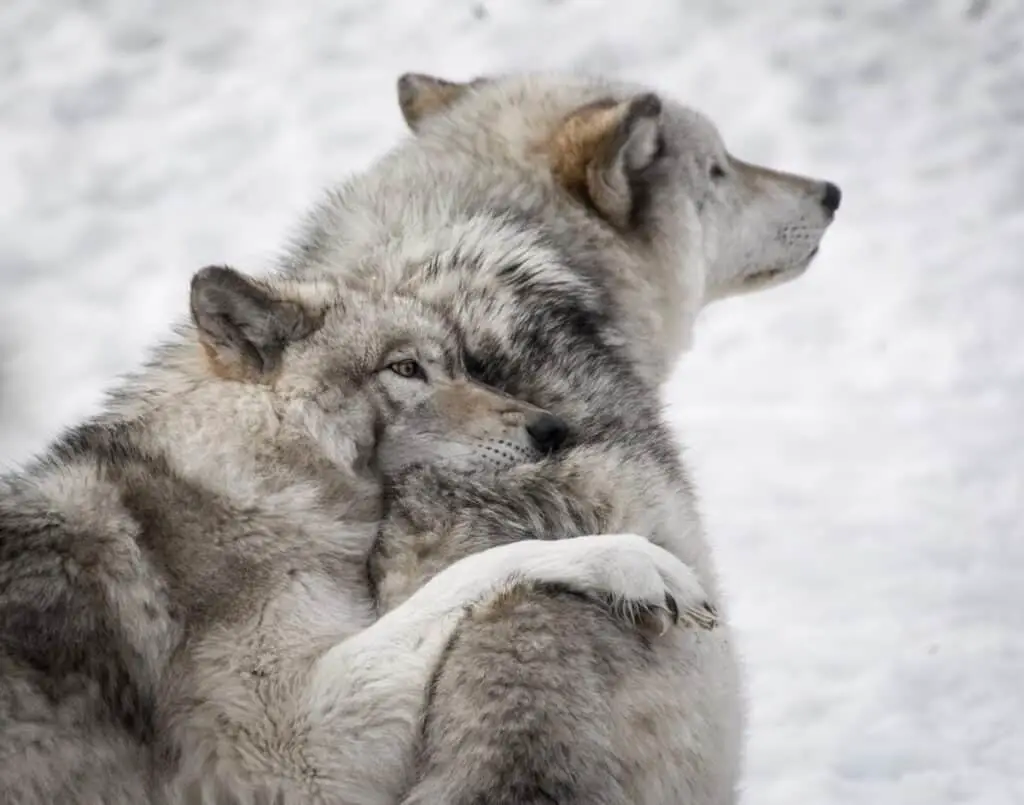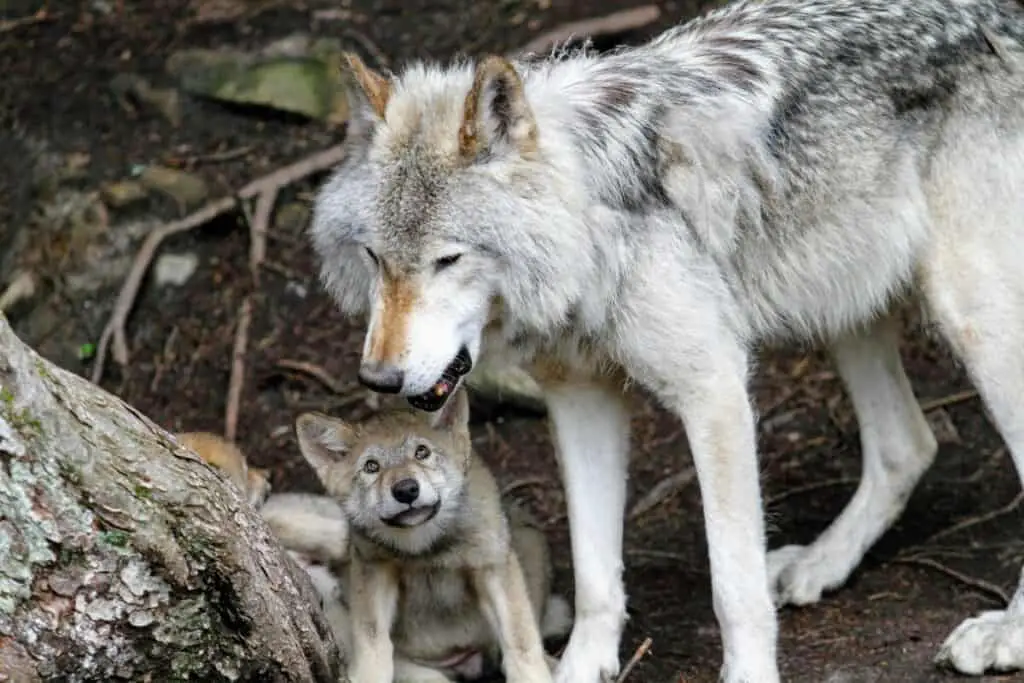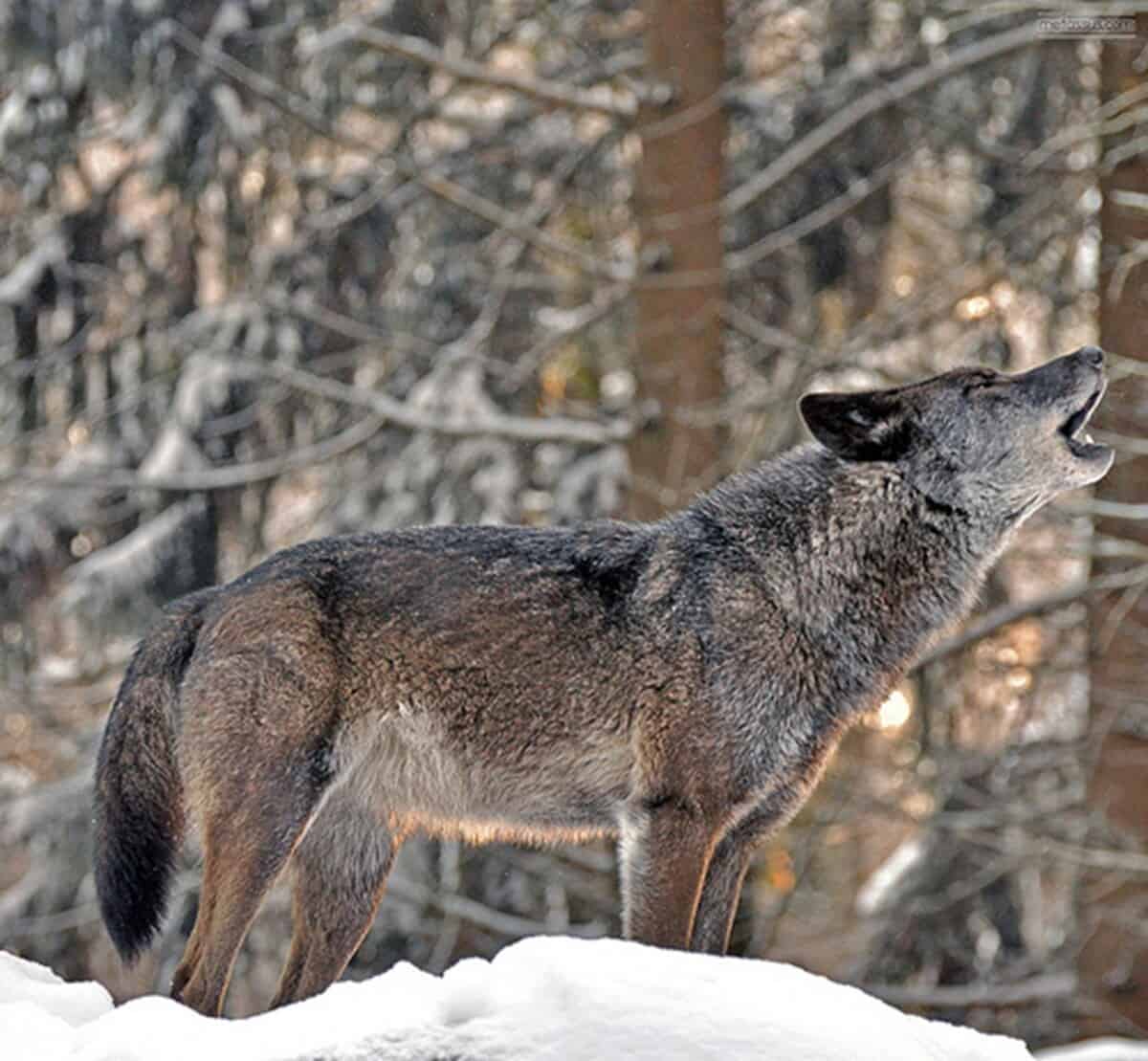Over many years of research as a biologist, one of the most fascinating topics I’ve run across is wolf communication and the science behind the haunting quality of a wolf’s howl.
Wolves communicate using vocalization, body language, scent, touch, and taste. Wolves howl to communicate with other pack members about their location, to organize group hunts, and to protect their territory from other packs. Alpha males will also leave scent markings to communicate with other packs. Wolves can also communicate using their eyes and the direction of their gaze.
First, let’s be clear about one thing: wolves do not howl at the moon. While this is a common misconception, research has shown that the phases of the moon have no effect on when and where wolves howl. (If you find yourself howling at the moon, please don’t try to convince others that you are merely imitating a wolf! LOL!)
When it comes to communicating with fellow pack members and with other packs, wolves are highly effective at getting their message across. I hope you’ll find the answers in this article as fascinating as I do.
Why do Wolves Howl?
Wolves howl to provide information about their location, as a signal for group hunts, and to communicate with other packs about territorial matters, such as asserting and protecting boundaries. Howling is one of the best ways for pack members to communicate with each other, especially over a long distance.
A wolf’s howl can be heard up to 10 miles (16 km) away in open terrain and can cover an area up to 50 sq miles (130 sq km). Lone wolves typically avoid howling in areas where other wolves are present. This makes sense when you consider that territorial fights are among the leading causes of injury and death for wolves.
When members of a wolf pack hear an adjacent pack howling, they are likely to remain in the same location to avoid interaction. As territorial animals, the dominant leaders try to maintain a safe distance between packs. Wolf howls are a good way of broadcasting location, judging distances from other wolves, and as a way of keeping nearby packs updated on pack movements.
Play the video below to listen to a wolf howl.
This will give you a good idea of the haunting quality that never fails to capture our attention. For many people, a wolf’s howl is simply beautiful to listen to. I think we can appreciate the sound even more when we understand the significance of howling within the pack and for communicating with other packs.
Wolves have a range of vocalizations and howls for different occasions:
- They use long, smooth howls when alerting fellow pack mates about a kill,
- They can use a higher pitched howl when pursuing prey,
- They use a combination of short barks and howls when closing in on their prey.
When howling together, wolves often harmonize on the same note to create the illusion of greater numbers.
Communication Within the Pack
As social creatures, communication between wolves is fundamental to the smooth functioning of the pack. Wolf packs are typically composed of an alpha pair and their young, including offspring from previous years. Unrelated loners may occasionally become members of a pack, but most intruders are chased away or killed.
The alpha pair mate for life, and they are the only members of a pack that will breed. If one of the dominant pair dies, a new alpha male or female will emerge and quickly take over as the mate.
Wolf packs have a strong hierarchy and, as pack leader, the alpha male is dominant over all other individuals. The alpha female is next in dominance and she is only subordinate to the alpha male.
An individual’s rank within the wolf pack is communicated by using body language and facial expressions, such as crouching, licking, touching faces, and rolling over to show the belly.

Body Language and Visual Communication
Even humans can distinguish between dominant and subordinate wolves by the way they carry themselves.
Alpha wolves exhibit a higher body posture with tail held high, and raised hackles when asserting dominance, while submissive wolves tend to carry their bodies lower, to flatten their fur, and to lower their ears and tail.
Tactile Communication
A self-assured alpha male will stand still and stare at a subordinate family member, as if expecting submissive behavior, which can be passive or active.
A passively submissive wolf will partially lie on its back and allow the dominant wolf to sniff its behind.
Active submission can take the form of a greeting, with the submissive wolf approaching the alpha in a low posture and licking their face. The mouthing of another wolf’s muzzle is a friendly gesture, while clamping bared teeth on the other’s muzzle is a display of dominance.

Olfactory Communication
Olfaction is probably the wolf’s most acute sense and plays a fundamental role in communication. Wolves can use scent to identify territorial boundaries, to signal fellow pack members, and to identify prey.
Wolves can identify individual pack mates by smell and can communicate using scent, such as marking recently hunted areas within their territory.
Urinating with a raised leg is one of the most important forms of scent communication in the wolf, making up 60–80% of all scent marks observed.
Vocalizations
In addition to howling, vocalizations include growls, barks, and whines.
Wolves usually bark when they are startled or alarmed and tend not to bark as loudly or continuously as dogs do. Wolves might bark a few times, but they would rather retreat if they perceive danger.
Pups almost never howl, while yearling wolves produce howls ending in a series of dog-like yelps. Pups commonly growl playfully, especially when play fighting.
Whining is associated with situations of anxiety, curiosity, inquiry, and intimacy such as greeting, feeding pups and playing.
Group celebrations are often noisy affairs with lots of whimpering and whining.
Wolves from different geographic regions may have different howls: as a generalization, European wolves have a more protracted and melodious howl than North American wolves.
Look and listen to this fun video of an Arctic wolf howling in the San Diego zoo in response to people howling.
How do Wolves Communicate When Hunting?
Wolves often howl to assemble the pack before and after hunts. Before going on a hunt, wolves will often hold a group rally, nuzzling one another’s muzzles and rubbing bodies, often accompanied by whimpering and whining. Once the hunt begins, however, they become much quieter as they get down to business.
Wolves Can Follow the Gaze of Another Wolf
Wolves do not use vocalization when approaching large prey animals such as elk, moose, and bison. They do however communicate with their eyes while hunting. They can follow the gaze direction of another wolf as an important source of information to help detect and track prey animals.
Wolves can even follow a gaze around a barrier, which is cognitively more advanced and much less common among animals. Researchers have found that wolves will go around an obstacle to check to see what another wolf or human is looking at, indicating that gaze following around a barrier is not restricted to primates and corvids (birds in the crow family, including jays, magpies, and ravens).
Following the gaze of another wolf in the pack can help with keeping up-to-date on important events within one’s social group or to help anticipate the upcoming actions of others.
As an aside, there’s a high likelihood that early humans became more effective hunters once they teamed up with wolves about 20,000 to 30,000 years ago. Even today, dogs are among the few animals that can follow the gaze of a human or a pointing finger as a form of silent communication. Of course, we know that dogs are no longer wolves; after many generations of domestication dogs have traits that we’ve selected to make them fit in better with human communities. Surprisingly, roughly 70-80% of the world’s dog population is made up of free-ranging dogs without owners.
For some interesting comparisons between wolves and domestic dogs, see my related article on Wolf-Dogs and Wolves. You might find it interesting to know that wolves are better at cooperating with one another than dogs are! Of course, the most interesting part is finding out why!
Communication Between Wolf Packs
Wolves advertise their territories to other packs mainly through howling and scent marking.
Scent marking involves urine, feces, and anal gland secretions and these markings are more effective at advertising territory than howling. Wolves increase their rate of scent marking when they encounter the marks of wolves from other packs. Lone wolves will rarely mark, but newly bonded pairs will scent mark the most.
Scent markings are generally left every 240 m (260 yd) throughout the territory on regularly traveled paths. These markers can last for two to three weeks, and are typically placed near prominent boulders, trees, or the bones of large animals. Wolves will mark their territory more often if they encounter any signs of outsiders. The result is a chemically defined boundary between packs… something that we, as humans, miss entirely when travelling through wolf territory.
We can see that wolves are excellent communicators, and, in laboratory tests, wolves appear to exhibit insight, foresight, understanding, and the ability to plan. Wolves are also excellent learners that can match or outperform domestic dogs, especially when it comes to cooperation.
You might also be interested in my article on Wolves & Wolf-dogs

Interested to learn how other species communicate?
See my article on Lion Communication to learn why lions roar – you might be surprised to know that one roar can mean life or death for the Lion King!

References
EOL.org Gray Wolf – Canis lupus https://eol.org/pages/328607/articles
San Diego Zoo Wildlife Alliance. Gray Wolf (Canis lupus) Fact Sheet. c2014-2019. San Diego (CA); [accessed 2020 Mar 09]. http://ielc.libguides.com/sdzg/factsheets/graywolf
Range F, Vira´nyi Z. Development of Gaze Following Abilities in Wolves (Canis Lupus). PLoS ONE, 6(2): e16888 DOI: 10.1371/journal.pone.0016888
Check Out Our TOP Articles for Even More Fascinating Creatures
- How do Octopus Reproduce? (Cannibalistic Sex, Detachable Penis)
- Why do Octopus have 3 Hearts, 9 Brains, and Blue Blood? Smart Suckers!
- Do Jellyfish have Brains? How Can they Hunt without Brains?
- Why are Deep Sea Fish So Weird and Ugly? Warning: Scary Pictures!
- Are Komodo Dragons Dangerous? Where Can you See Them?
- Koala Brains – Why Being Dumb Can Be Smart (Natural Selection)
- Why do Lions Have Manes? (Do Dark Manes Mean More Sex?)
- How Do Lions Communicate? (Why Do Lions Roar?)
- How Dangerous are Stonefish? Can You Die if You Step on One?
- What Do Animals Do When They Hibernate? How do they Survive?
- Leaf Cutter Ants – Surprising Facts and Adaptations; Pictures and Videos
- Irukandji Jellyfish Facts and Adaptations; Can They Kill You? Are they spreading?
- How to See MORE Wildlife in the Amazon: 10 Practical Tips
- Is it Safe to go on Safari with Africa’s Top Predators and Most Dangerous Animals?
- What to Do if You Encounter a Bullet Ant? World’s Most Painful Stinging Insect!
- How Do Anglerfish Mate? Endless Sex or Die Trying!
- How Smart are Crocodiles? Can They Cooperate, Communicate…Use Tools?
- How Can We Save Our Oceans? With Marine Sanctuaries!
- Why Are Male Birds More Colorful? Ins and Outs of Sexual Selection Made Easy!
- Why is the Cassowary the Most Dangerous Bird in the World? 10 Facts
- How Do African Elephants Create Their Own Habitat?
- What is Killing Our Resident Orcas? Endangered Killer Whales
- Why are Animals of the Galapagos Islands Unique?
- Where Can You See Wild Lemurs in Madagascar? One of the Best Places
- Where Can You see Lyrebirds in the Wild? the Blue Mountains, Australia
- Keeping Mason Bees as Pets
- Why do Flamingos have Bent Beaks and Feed Upside Down?
- Why are Hippos Dangerous? Why Do They Kill People?


